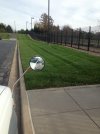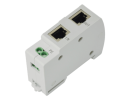I'm considering swapping my PoE setup for fiber on my cameras for reasons of better lightning survivability (lightning just blowing up a camera nearby rather than half of the system as it happened once for me). My cameras are mounted on 6m tall steel poles which are 1.5m in the ground. So 4.5m.above ground and two cameras on each pole.
I wonder what about power. Someone may say "What about it? Just run AC 240V(this being our voltage) same as for anything else and use normal surge protection" However that is a copper cable that will be exposed to the same risk PoE cables were, also same issues with grounding and so on. I can put in surge protectors (just like I can on PoE), but if these surge protectors get overwhelmed I can potentially destroy a lot more expensive equipment connected to AC power than a couple of cameras and switches...
Then there is the cost of running AC power properly that seems much higher than just running PoE for both.
Finally there is the fact I currently just need a small sealed box to terminate the copper in and have a tiny poe splitter for cameras that do not support PoE out of the box. This box would have to become much bigger to fit a media converter, ac fuses and AC surge protection.
I'd love to read about your experiences with this if you live in a high lightning area of not? Is there much benefit to fiber outdoors on distances where copper works fine?
Are there some unexpected advantages/disadvantages of fiber I'm not thinking of? What about the efficiency of power? My system of 11 cameras and various switching equipment consumes 150W most of the time. While electricity is free in the summer for me (thanks to PV/batteries) in the winter I pay quite a bit and the Cctv system is probably responsible for 20% of my entire bill because it's running 24/7. I'd think perhaps PoE switches are more effecient at AC->low voltage DC conversion than "wall warts" sold with cameras, but maybe it's the opposite?
Edit: Also PoE is handy for occasionally (or regularly) restarting cameras which freeze/crash so you can't manage them. If this was using AC power.id have to use some IP relays. Probably out in the box with the media converter.
I wonder what about power. Someone may say "What about it? Just run AC 240V(this being our voltage) same as for anything else and use normal surge protection" However that is a copper cable that will be exposed to the same risk PoE cables were, also same issues with grounding and so on. I can put in surge protectors (just like I can on PoE), but if these surge protectors get overwhelmed I can potentially destroy a lot more expensive equipment connected to AC power than a couple of cameras and switches...
Then there is the cost of running AC power properly that seems much higher than just running PoE for both.
Finally there is the fact I currently just need a small sealed box to terminate the copper in and have a tiny poe splitter for cameras that do not support PoE out of the box. This box would have to become much bigger to fit a media converter, ac fuses and AC surge protection.
I'd love to read about your experiences with this if you live in a high lightning area of not? Is there much benefit to fiber outdoors on distances where copper works fine?
Are there some unexpected advantages/disadvantages of fiber I'm not thinking of? What about the efficiency of power? My system of 11 cameras and various switching equipment consumes 150W most of the time. While electricity is free in the summer for me (thanks to PV/batteries) in the winter I pay quite a bit and the Cctv system is probably responsible for 20% of my entire bill because it's running 24/7. I'd think perhaps PoE switches are more effecient at AC->low voltage DC conversion than "wall warts" sold with cameras, but maybe it's the opposite?
Edit: Also PoE is handy for occasionally (or regularly) restarting cameras which freeze/crash so you can't manage them. If this was using AC power.id have to use some IP relays. Probably out in the box with the media converter.




